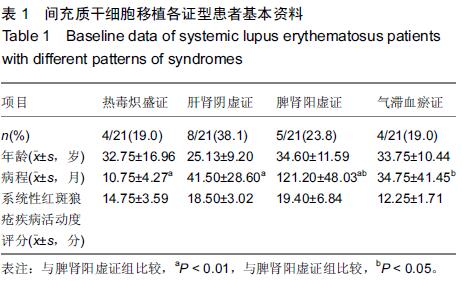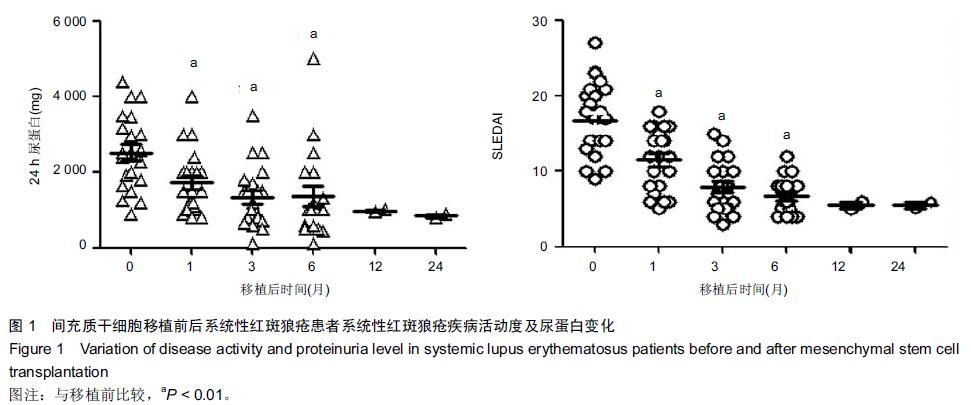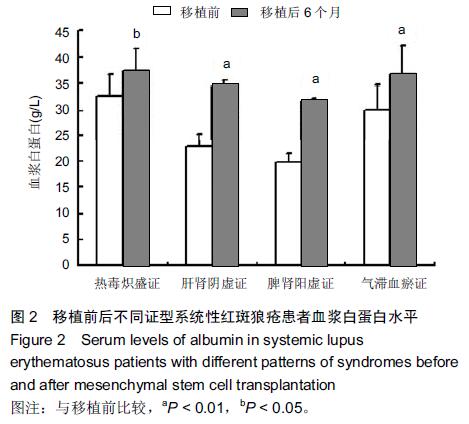[2] 国家中医药管理局.中华人民共和国中医药行业标准,中医病证诊断疗效标准[M].南京:南京大学出版社,1994.
[3] 沈丕安.红斑狼疮中医临床研究[M] .北京:人民卫生出版社, 1997.
[4] Wang D, Li J, Zhang Y, et al. Umbilical cord mesenchymal stem cell transplantation in active and refractory systemic lupus erythematosus: a multicenter clinical study. Arthritis Res Ther. 2014;16(2):R79.
[5] Sun LY, Akiyama K, Zhang HY, et al. Mesenchymal stem cell transplantation reverses multi-organ dysfunction in systemic lupus erythematosus mice and humans. Stem Cells. 2009; 27(6): 1421-1432.
[6] Wang DD, Akiyama K, Zhang HY, et al. Double allogenic mesenchymal stem cells transplantations could not enhance therapeutic effect compared with single transplantation in systemic lupus erythematosus. Clin Dev Immunol. 2012;2012: 273291.
[7] Liang J, Zhang HY, Hua BZ, et al. Allogenic mesenchymal stem cells transplantation in refractory systemic lupus erythematosus: a pilot clinical study. Ann Rheum Dis. 2010; 69:1423-1429.
[8] Xu J, Wang D, Liu D, et al. Allogeneic mesenchymal stem cell treatment alleviates experimental and clinical Sjögren syndrome. Blood. 2012;120(15):3142-3151.
[9] Wang D, Zhang H, Cao M. Efficacy of allogeneic mesenchymal stem cell transplantation in patients with drug-resistant polymyositis and dermatomyositis. Ann Rheum Dis. 2011;70(7):1285-1288.
[10] Tan EM, Cohen AS, Fries JF, et al. The 1982 revised criteria for the classification of systemic lupus erythematosus. Arthritis Rheum. 1982;25:1271-1277.
[11] Yee CS, Farewell VT, Isenberg DA, et al. The use of Systemic Lupus Erythematosus Disease Activity Index-2000 to define active disease and minimal clinically meaningful change based on data from a large cohort of systemic lupus erythematosus patients. Rheumatology (Oxford). 2011;50(5): 982-988
[12] Lu LL, Liu YJ, Yang SG, et al. Isolation and characterization of human umbilical cord mesenchymal stem cells with hematopoiesis-supportive function and other potentials. Haematologica. 2006;91:1017-1026.
[13] Wetzig A, Alaiya A, Al-Alwan M, et al. Differential marker expression by cultures rich in mesenchymal stem cells. BMC Cell Biol. 2013;14:54.
[14] Chen JY, Mou XZ, Du XC, et al. Comparative analysis of biological characteristics of adult mesenchymal stem cells with different tissue origins. Asian Pac J Trop Med. 2015;8(9): 739-746.
[15] Tao R, Sun TJ, Han YQ, et al. Optimization of in vitro cell labeling methods for human umbilical cord-derived mesenchymal stem cells. Eur Rev Med Pharmacol Sci. 2014; 18(8):1127-1134.
[16] 汤郁,雷芳,宋东明,等.脐带间充质干细胞治疗结缔组织病不良反应分析[J].南京医科大学学报:自然科学版,2014,12(12): 1687-1689.
[17] 孙然,侯云峰,于秀明,等.93例系统性红斑狼疮中医辨证分型的抗核抗体谱与肿瘤坏死因子分析[J].中华中医药杂志,2008, 23(12): 1125-1128.
[18] 鲍晓辉,叶诚焯,赵明山,等.系统性红斑狼疮的瘀血病理探讨[J].实用中西医结合杂志,1997,10(7):660- 661.
[19] Pittenger MF, Mackay AM, Beck SC, et al. Multilineage potential of adult human mesenchymal stem cells. Science. 1999;284:143.
[20] Kmiecik G, Spoldi V, Silini A, et al. Current view on osteogenic differentiation potential of mesenchymal stromal cells derived from placental tissues. Stem Cell Rev. 2015;11(4):570-585.
[21] Yan Z, Zhuansun Y, Liu G, et al. Mesenchymal stem cells suppress T cells by inducing apoptosis and through PD-1/B7-H1 interactions. Immunol Lett. 2014;162(1 Pt A): 248-255.
[22] Ma S, Xie N, Li W, et al. Immunobiology of mesenchymal stem cells. Cell Death Differ. 2014;21(2):216-225.
[23] Castro-Manrreza ME, Mayani H, Monroy-García A, et al. Human mesenchymal stromal cells from adult and neonatal sources: a comparative in vitro analysis of their Immunosuppressive properties against T cells. Stem Cells Dev. 2014;23(11):1217-1232.
[24] Oubari F, Amirizade N, Mohammadpour H, et al. The important role of flt3-l in ex vivo expansion of hematopoietic stem cells following co-culture with mesenchymal stem cells. Cell J. 2015;17(2):201-210.
[25] Alcayaga-Miranda F, Cuenca J, Luz-Crawford P, et al. Characterization of menstrual stem cells: angiogenic effect, migration and hematopoietic stem cell support in comparison with bone marrow mesenchymal stem cells. Stem Cell Res Ther. 2015;6(1):32.
[26] Al-Nbaheen M, vishnubalaji R, Ali D, et al. Human stromal (mesenchymal) stem cells from bone marrow, adipose tissue and skin exhibit differences in molecular phenotype and differentiation potential. Stem Cell Rev. 2013;9(1):32-43.
[27] Baksh D, Yao R, Tuan RS. Comparison of proliferative and multilineage differentiation potential of human mesenchymal stem cells derived from umbilical cord and bone marrow. Stem Cells. 2007;25(11):1384-1392.
[28] 张进,徐志伟. “肾藏精、主骨、生髓”理论内涵辨析[J].中国中医基础医学杂志,2009,15(11):805-809.
[29] 顾志峰,金鸥阳,徐婷,等.脐带间充质干细胞移植治疗MRL/lpr狼疮鼠的疗效[J].中华风湿病学杂志,2009,13(1):4-7.
[30] Kwon MJ, Kang SJ, Park YI, et al. Hepatic differentiation of human adipose tissue-derived mesenchymal stem cells and adverse effects of arsanilic acid and acetaminophen during in vitro hepatic developmental stage. Cell Biol Toxicol. 2015; 31(3):149-159.
[31] Zhou X, Loomis-King H, Gurczynski SJ, et al. Bone marrow transplantation alters lung antigen-presenting cells to promote TH17 response and the development of pneumonitis and fibrosis following gammaherpesvirus infection. Mucosal Immunol. 2015.
[32] Malara A, Abbonante V, Di Buduo CA, et al. The secret life of a megakaryocyte: emerging roles in bone marrow homeostasis control. Cell Mol Life Sci. 2015;72(8):1517-1536.
[33] Klamer S, Voermans C. The role of novel and known extracellular matrix and adhesion molecules in the homeostatic and regenerative bone marrow microenvironment. Cell Adh Migr. 2014;8(6):563-577.
[34] Vainshtein JM, Kabarriti R, Mehta KJ, et al. Bone marrow-derived stromal cell therapy in cirrhosis: clinical evidence, cellular mechanisms, and implications for the treatment of hepatocellular carcinoma. Int J Radiat Oncol Biol Phys. 2014;89(4):786-803.
[35] Klamer SE, Kuijk CG, Hordijk PL, et al. BIGH3 modulates adhesion and migration of hematopoietic stem and progenitor cells. Cell Adh Migr. 2013;7(5):434-449.
[36] Hong H, Shi Z, Qiao P, et al. Interleukin-3 plays dual roles in osteoclastogenesis by promoting the development of osteoclast progenitors but inhibiting the osteoclastogenic process. Biochem Biophys Res Commun. 2013;440(4):545-550.
[37] Zimmerlin L, Park TS, Zambidis ET, et al. Mesenchymal stem cell secretome and regenerative therapy after cancer. Biochimie. 2013;95(12):2235-2245.
[38] Lazar-Karsten P, Dorn I, Meyer G, et al. The influence of extracellular matrix proteins and mesenchymal stem cells on erythropoietic cell maturation. Vox Sang. 2011;101(1):65-76.
[39] Nystedt J, Anderson H, Hirvonen T, et al. Human CMP-N-acetylneuraminic acid hydroxylase is a novel stem cell marker linked to stem cell-specific mechanisms. Stem Cells. 2010;28(2):258-267.
[40] Tsai S, Butler J, Rafii S, et al. The role of progenitor cells in the development of intimal hyperplasia. J Vasc Surg. 2009; 49(2):502-510.
[41] Mesenchymal stem cells alter migratory property of T and dendritic cells to delay the development of murine lethal acute graft-versus-host disease. Stem Cells. 2008;26:2531-2541.
[42] 邓迎苏,陈志伟,顾美华,等.系统性红斑狼疮多系统损害与中医辨证关系[J].上海医药大学学报,2000,4(4):27-28.



